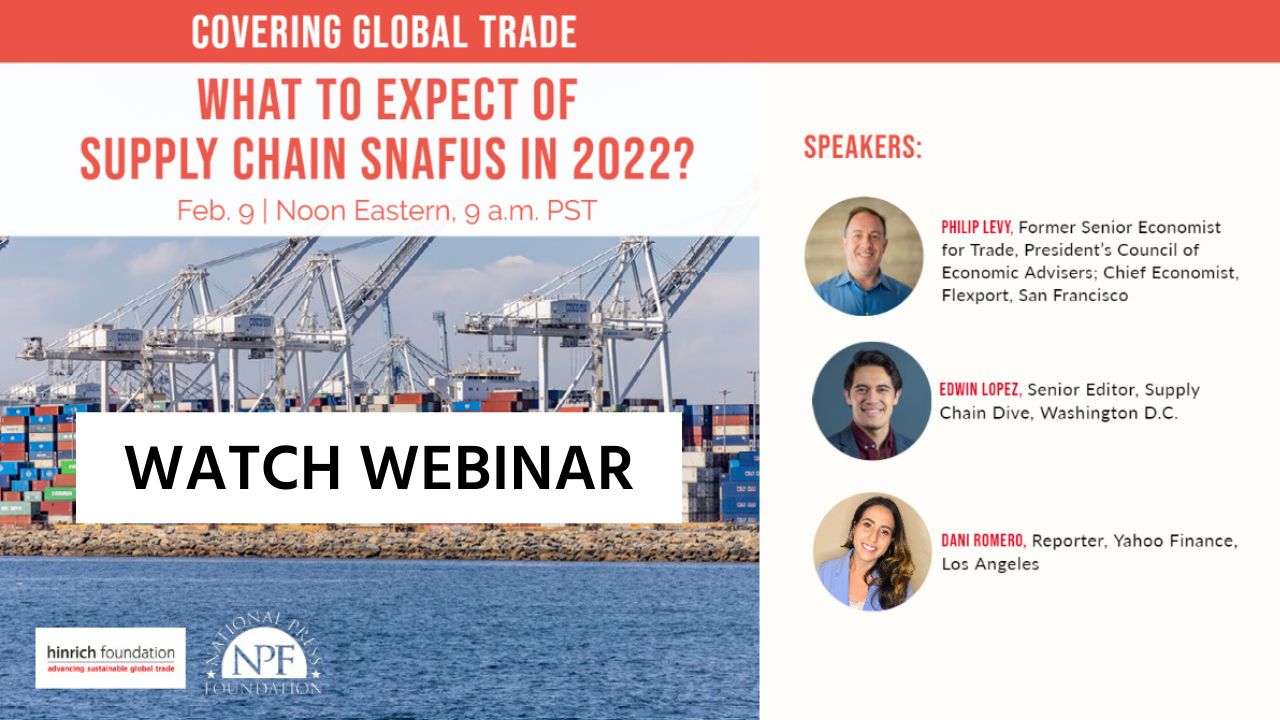What to expect of supply chain snafus in 2022?
Published 15 February 2022
Congestion in US ports is causing severe supply chain disruptions across different sectors. What is driving these latest snafus and what are the trends we should look out for? Watch a recap of this National Press Foundation briefing, sponsored by the Hinrich Foundation, to gain a deeper understanding of this sprawling global story.
Supply chain disruptions in the US are blamed for increasing inflation, delaying delivery of Covid-19 test kits, and bedeviling the Biden administration's efforts to improve the American economy. In this webinar, three experts explained what is affecting supply chains, how the impacts could be measured, and why the word "shortage" should be used more sparingly. Here are five key takeaways:
1. The average ocean journey for cargo has lengthened from 40 to 50 days in 2019 to 110 days in 2022.
That’s a key indicator analysts can use to monitor the supply chain crisis and track whether it is improving, said Philip Levy, chief economist at Flexport, a global logistics firm in San Francisco. Supply chain problems have affected sectors differently and have shifted during the pandemic, so each sector must be examined separately. Inflation is now also having an effect. Levy’s overview of global logistics pressures is here.
2. Stop using the word “shortage.”
There is a better story lurking behind an empty shelf, advised Edwin Lopez, senior editor at Supply Chain Dive. Is there a toilet paper shortage because people are buying more toilet paper? Or because toilet paper used to be delivered to offices instead of supermarkets? Or because the ship or truck didn’t arrive? Or because there were not enough workers to put the toilet paper on the shelves? Or because the store manager did not order enough from corporate headquarters? Or because the manufacturer was not able to produce enough to keep up with demand? “After having covered supply chain shortages for six months, it’s time to go a little bit deeper,” Lopez said. “There are more than enough of those stories to tell. We just have to ask ourselves the right question on how to tell them.”
3. Cover how businesses are adapting, investing and leading on resilience – and go talk to the workers.
Ask companies how they are reinforcing or diversifying their supply chains and look for clues in new investments, such as shifts in manufacturing locations or new warehouses opening, Lopez said. “Every new facility that is invested or that changes hands has a story,” Lopez said. Each investment represents an assumption - dig into the forecasts that underlie investors’ assumptions, Levy added. Dani Romero, who is covering congestion in the ports for Yahoo Finance in Los Angeles said she learned last weekend from contract truck drivers, longshoremen and women that some businesses have cargo stuck in the ports because they haven’t paid the fees to get their containers out. Find out who will cover the costs of snagged supply chains, including rising container fees. “Will this be a shipping company that ends up paying this? Will this end up being passed on to a client?” Levy asked. “These things aren’t necessarily obvious.”
4. The economics behind the supply chain woes are fascinating – and puzzling.
The pandemic caused a sharp recession, but unlike other recessions, demand for consumer goods and imported goods spiked, Levy said. Government stimulus also boosted demand for durables – and nobody knows whether consumption of goods will drop again once pandemic restrictions ease and people can travel and consumers demand services again. “It’s an extraordinarily difficult time to forecast,” Levy said. “We don’t have lots of great examples of modern pandemics to look back on.”
5. If Russia invades Ukraine, look for disruption to air cargo, not shipping.
A Russian invasion of Ukraine would have a big effect on global energy markets, but not a significant direct effect on global supply chains, Levy said. Only about 5% of global cargo moves by air, and only a fraction of that is cargo passing over Russian or Ukrainian territory, he said. The industries most likely to be affected are consumer electronics and fast fashion, where goods may be shipped by air from Asia to Europe. Then there are indirect effects on people’s confidence, Levy said. Watch global semiconductor supply chains, Lopez added. “Suppliers have to make a choice every day, every week, every month, of which client they supply first,” Lopez noted. “And a lot of semiconductor capacity suppliers are based out of China, or China-influenced locations.” If the U.S. and its allies were to choke off semiconductor sales to Russia, would China then prioritize semiconductor shipments to Russia instead of the U.S.? “How will that affect the Teslas, the Apples of the world, that are also getting materials from [China]?” Lopez said.
***
Telling the global trade story
This briefing is part of a series of National Press Foundation's online webinars covering all aspects of global trade.
© The Hinrich Foundation. See our website Terms and conditions for our copyright and reprint policy. All statements of fact and the views, conclusions and recommendations expressed in this publication are the sole responsibility of the author(s).


